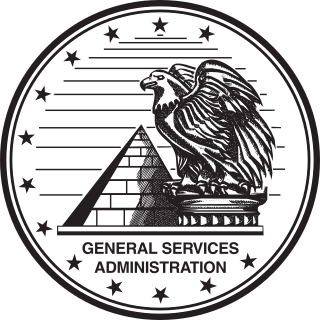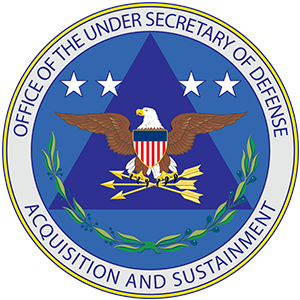Related Research Articles

The Office of Management and Budget (OMB) is the largest office within the Executive Office of the President of the United States (EOP). OMB's most prominent function is to produce the president's budget, but it also examines agency programs, policies, and procedures to see whether they comply with the president's policies and coordinates inter-agency policy initiatives.
Independent agencies of the United States federal government are agencies that exist outside the federal executive departments and the Executive Office of the President. In a narrower sense, the term refers only to those independent agencies that, while considered part of the executive branch, have regulatory or rulemaking authority and are insulated from presidential control, usually because the president's power to dismiss the agency head or a member is limited.
The United States order of precedence is an advisory document maintained by the Ceremonials Division of the Office of the Chief of Protocol of the United States which lists the ceremonial order, or relative preeminence, for domestic and foreign government officials at diplomatic, ceremonial, and social events within the United States and abroad. The list is used to mitigate miscommunication and embarrassment in diplomacy, and offer a distinct and concrete spectrum of preeminence for ceremonies. Often the document is used to advise diplomatic and ceremonial event planners on seating charts and order of introduction. Former presidents, vice presidents, first ladies, second ladies, and secretaries of state and retired Supreme Court justices are also included in the list.

The General Services Administration (GSA) is an independent agency of the United States government established in 1949 to help manage and support the basic functioning of federal agencies. GSA supplies products and communications for U.S. government offices, provides transportation and office space to federal employees, and develops government-wide cost-minimizing policies and other management tasks.

The Defense Science Board (DSB) is a committee of civilian experts appointed to advise the U.S. Department of Defense on scientific and technical matters. It was established in 1956 on the recommendation of the second Hoover Commission.

The Risk Management Agency (RMA) is an agency of the U.S. Department of Agriculture, which manages the Federal Crop Insurance Corporation (FCIC). The current Administrator is Marcia Bunger.

The Defense Contract Management Agency (DCMA) is an agency of the United States federal government reporting to the Under Secretary of Defense for Acquisition and Sustainment. It is responsible for administering contracts for the Department of Defense (DoD) and other authorized federal agencies. Its headquarters is located at Fort Lee, Virginia. DCMA sometimes handles Foreign Military Sales contracts.
The Federal Acquisition Regulation (FAR) is the principal set of rules regarding Government procurement in the United States, and is codified at Chapter 1 of Title 48 of the Code of Federal Regulations, 48 CFR 1. It covers many of the contracts issued by the US military and NASA, as well as US civilian federal agencies.
A Contracting Officer's Technical Representative (COTR) is a business communications liaison between the United States government and a private contractor. The COTR is normally a federal or state employee who is responsible for recommending actions and expenditures for both standard delivery orders and task orders, and those that fall outside of the normal business practices of its supporting contractors and sub-contractors. Most COTRs have experience in the technical area that is critical to the success of translating government requirements into technical requirements that can be included in government acquisition documents for potential contractor to bid and execute that work. A COTR must be designated by a Contracting Officer (CO). The CO has the actual authority to enter into, administer, and/or terminate contracts and make related determinations and findings. Other terms for COTR include Contracting Officer's Representative (COR) and Project Officer (PO). The terminology may be agency specific.
In the United States, the processes of government procurement enable federal, state and local government bodies in the country to acquire goods, services, and interests in real property.
The Information Technology Management Reform Act of 1996 is a United States federal law, designed to improve the way the federal government acquires, uses and disposes information technology (IT). It was passed as Division E of the National Defense Authorization Act for Fiscal Year 1996. Together with the Federal Acquisition Reform Act of 1996, it is known as the Clinger–Cohen Act.
The Appointments Clause of the United States Constitution empowers the President of the United States to nominate and, with the advice and consent (confirmation) of the United States Senate, appoint public officials. Although the Senate must confirm certain principal officers, Congress may by law invest the appointment of "inferior" officers to the President alone, or to courts of law or heads of departments.
Executive Schedule is the system of salaries given to the highest-ranked appointed officials in the executive branch of the U.S. government. The president of the United States appoints individuals to these positions, most with the advice and consent of the United States Senate. They include members of the president's Cabinet, several top-ranking officials of each executive department, the directors of some of the more prominent departmental and independent agencies, and several members of the Executive Office of the President.

The Under Secretary of Defense for Acquisition and Sustainment, or USD(A&S), is the Principal Staff Assistant (PSA) and advisor to the Secretary of Defense for all matters relating to acquisition and sustainment in the Department of Defense. This includes the DoD Acquisition System; system design and development; production; logistics and distribution; installation maintenance, management, and resilience; military construction; procurement of goods and services; material readiness; maintenance; environment and energy resilience ; utilities; business management modernization; International Armaments Cooperation, Cooperative Acquisition and International Agreements, Promoting exportability of military components to allies and partners; nuclear, chemical and biological defense programs; and nuclear command, control, and communications.
The Public Service of Canada is the civilian workforce of the Government of Canada's departments, agencies, and other public bodies.
The Office of the United States Assistant Secretary of the Army for Acquisition, Logistics, and Technology (ASA(ALT) pronounced A-salt) is known as OASA(ALT). OASA(ALT) serves, when delegated, as the Army Acquisition Executive, the Senior Procurement Executive, the Science Advisor to the Secretary of the Army, and as the senior research and development official for the Department of the Army. The OASA(ALT) also has the principal responsibility for all Department of the Army matters related to logistics.
According to the United States Office of Government Ethics, a political appointee is "any employee who is appointed by the President, the Vice President, or agency head". As of 2016, there were around 4,000 political appointment positions which an incoming administration needs to review, and fill or confirm, of which about 1,200 require Senate confirmation. The White House Presidential Personnel Office (PPO) is one of the offices most responsible for political appointees and for assessing candidates to work at or for the White House.

The Federal Information Technology Acquisition Reform Act made changes to the ways the U.S. federal government buys and manages computer technology. It became law as a part of the National Defense Authorization Act for Fiscal Year 2015 (Title VIII, Subtitle D, H.R. 3979.
References
- ↑ Kennedy, J. L. and Cornelius, R. A., Contracting officer's representatives: What to expect, Army Sustainment, published 31 January 2019, accessed 20 February 2020
- ↑ "AFFARS". www.acquisition.gov. Retrieved 2023-03-02.
- ↑ Acquisition